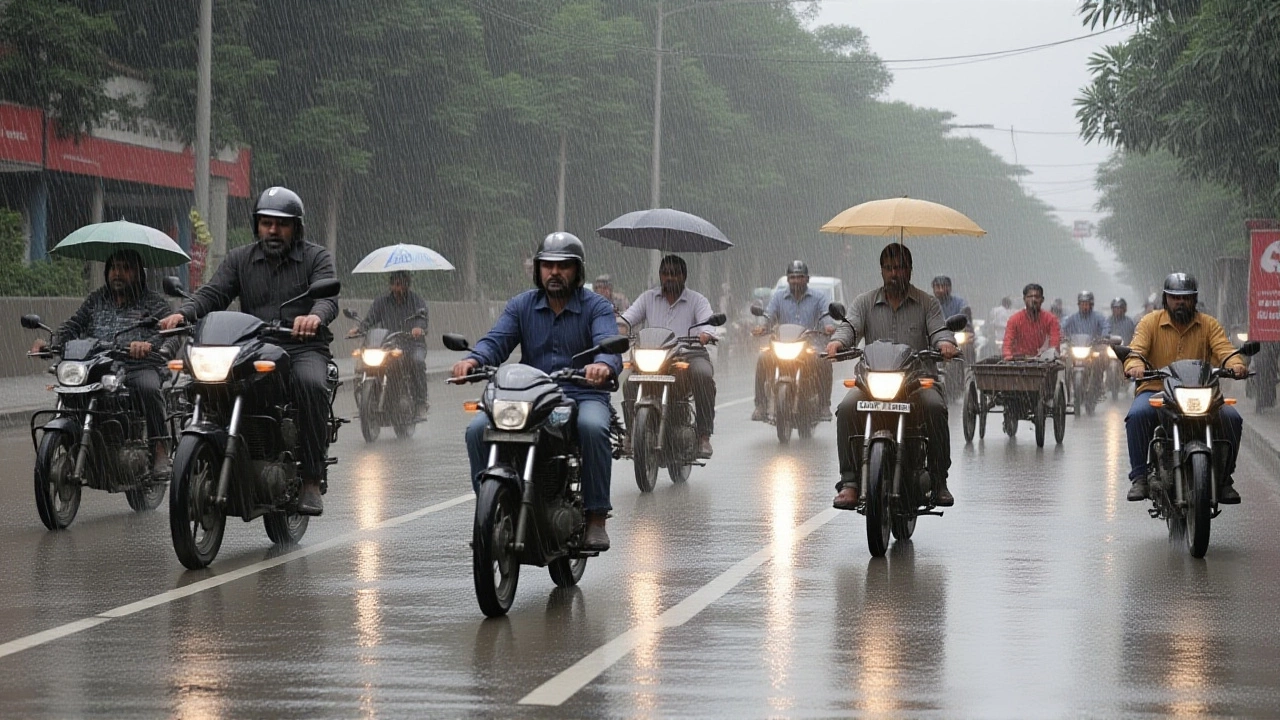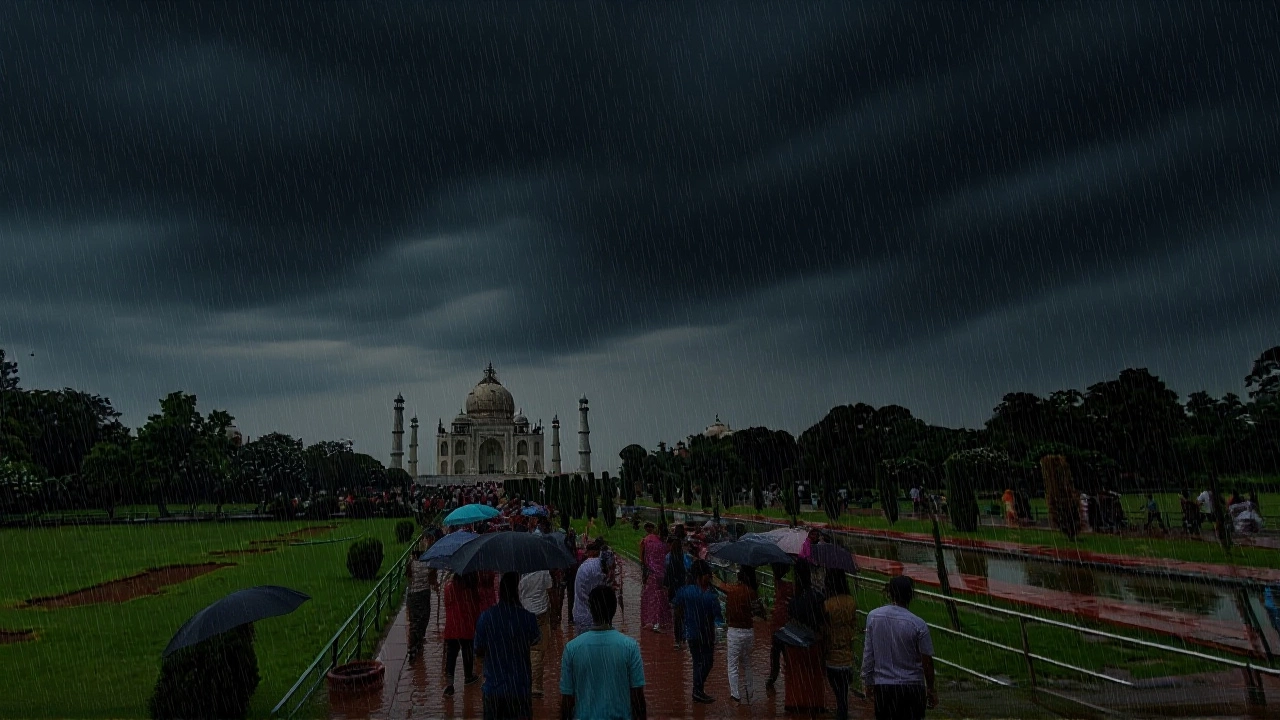Heavy Rain & Hail Forecast Hits North India Ahead of Dussehra

The India Meteorological Department (IMD) issued an alarming outlook on 2 October 2025, saying that heavy rain and hail could batter north‑India just as the Dussehra festivities kick off. Dr. Rajesh Kumar, chief forecaster at the IMD, highlighted a fresh Western Disturbance set to sweep across the region from 4 October. The timing coincides with DussehraNorth India, the country’s biggest autumn celebration.
Atmospheric Setup and Forecast Overview
At the heart of the coming storm is an upper‑air cyclonic circulation hovering over Arunachal Pradesh and its neighboring states. This low‑level vortex is pulling moist air from both the Arabian Sea and the Bay of Bengal, creating a perfect recipe for prolonged precipitation. By 5 October the system is expected to deepen, with the most intense burst projected for 6 October – the day of Vijayadashami.
IMD’s extended forecast paints a picture of daily maximum temperatures ranging between 30 °C and 33 °C across the north, while nocturnal lows hover around 19 °C. Sunlight will be scarce, with the nation averaging just nine hours of sunshine per day in October.
Regional Rainfall Outlook
Northwest India – states such as Punjab, Haryana, and Rajasthan will see scattered thunderstorms from 4 October onward, courtesy of the Western Disturbance. Heavy to very heavy rain, accompanied by hailstones the size of garden peas, could hit as early as 5 October, peaking on 6 October. Wind speeds may gust up to 30 km/h, amplifying the risk of localized flooding.
East and Central India – Isolated downpours of 21 cm or more are forecast for Chhattisgarh and Odisha on 2 October, while Bihar could face similar extremes on 3 October and 4 October. The meteorological models also show a higher‑than‑average chance of very heavy rain over Gangetic West Bengal and Jharkhand during the same window.
In the capital, Delhi, temperatures are staying pleasant at 19.2 °C‑31.8 °C, with humidity hovering around 44 % and light showers expected in the evenings. Current observations (9:51 PM) note scattered clouds and breezes of 4 km/h.
- Maximum daily rainfall predicted: 21 cm (Bihar, Chhattisgarh, Odisha)
- Peak hail event: 6 October, north‑west corridor
- Total October rainfall forecast: 106 mm
- Average UV index: 7 (high)
- Sunny hours: ~11 hours per day
Impact on Dussehra Celebrations
Dussehra draws millions of devotees to fire‑crackers, processions, and open‑air fairs. The forecast means many traditional gatherings could be delayed or relocated. In Jaipur, where the famed Rajasthani procession snakes through the old city, organizers are already scouting covered arenas. In Ahmedabad, heat‑tolerant clothing and hydration stations are being set up, as daytime temps may touch 36 °C.
Travel agencies warn that road conditions on highways connecting Delhi, Jaipur, and Lucknow could deteriorate sharply after 5 October, especially in low‑lying stretches prone to water‑logging. The Indian Railways has pre‑emptively added extra buses and halt stations to help pilgrims reach their destinations safely.

Expert Opinions and Safety Recommendations
"The convergence of a Western Disturbance with abundant tropical moisture is rare for early October," said Prof. Ananya Ghosh of the Indian Institute of Tropical Meteorology. "If we don’t see the usual post‑monsoon lull, residents should treat the next three days as a winter‑like scenario – carry waterproof gear and avoid unnecessary outdoor exposure."
Local health officials recommend drinking at least 2 litres of water daily, as humidity levels (30‑40 %) can make the heat feel more oppressive. For those attending dusk‑time fireworks, a simple rule of thumb: stay at least 30 metres away from launch sites and keep children under close supervision.
Utility companies in Delhi and surrounding districts have issued power‑cut alerts for 6 October, citing the high likelihood of storm‑related line faults. Citizens are advised to keep flashlights and mobile chargers handy.
Looking Ahead: October Weather Trends
Beyond the Dussehra window, forecasters anticipate a gradual return to drier conditions by mid‑October. However, climate analysts point out that the recent spike in October temperatures – averaging 27 °C‑33 °C nationwide – is part of a broader warming trend linked to the Indian Ocean Dipole’s positive phase.
For the rest of the month, IMD predicts roughly four rainy days, a total of about 106 mm of precipitation, and an average of 11.6 hours of sunshine per day. Travelers heading to hill stations like Shimla or Darjeeling should pack both light jackets and raincoats, as micro‑climates can shift dramatically.
Frequently Asked Questions
How will the forecast affect Dussehra celebrations in Delhi?
Delhi’s festivals are likely to move to indoor venues or be rescheduled by a day. Organizers are preparing covered stages, extra drainage, and medical tents to handle sudden showers and hail. Attendees should carry umbrellas and avoid standing under temporary structures during peak rain hours (5‑7 October).
What safety measures should travelers take when passing through Bihar during the heavy rain period?
Drivers should check road‑condition updates before departure, keep headlights on, and avoid low‑lying bridges that may be submerged. Carry a basic emergency kit – dry clothes, bottled water, a flashlight, and a first‑aid box. If you’re on a train, listen for announcements about possible delays or cancellations.
Why is a Western Disturbance expected to bring hail to northwest India this October?
A Western Disturbance is an extratropical cyclone that carries cold air from the Mediterranean region toward South Asia. When this cold air meets the warm, moisture‑laden air from the Arabian Sea, the rapid temperature contrast can produce strong updrafts, leading to hail formation – a phenomenon more common in the pre‑winter months.
What temperature extremes can residents expect across India in October 2025?
Daytime highs will generally stay between 30 °C and 33 °C, with some inland cities like Ahmedabad touching 36 °C. Nighttime lows will dip to around 17 °C in northern hill‑top areas such as Amritsar, while coastal regions remain milder at about 19 °C. Overall, the month remains warm but the sudden rain bursts will make it feel cooler in affected zones.
Are there any long‑term climate implications of this early‑October rainfall?
Climatologists note that the Indian Ocean Dipole shifted to a positive phase this year, pushing extra moisture northward. If such patterns persist, October could become a secondary rainy window, altering agricultural calendars and water‑resource planning across the sub‑continent.